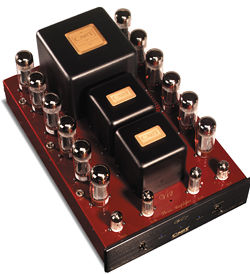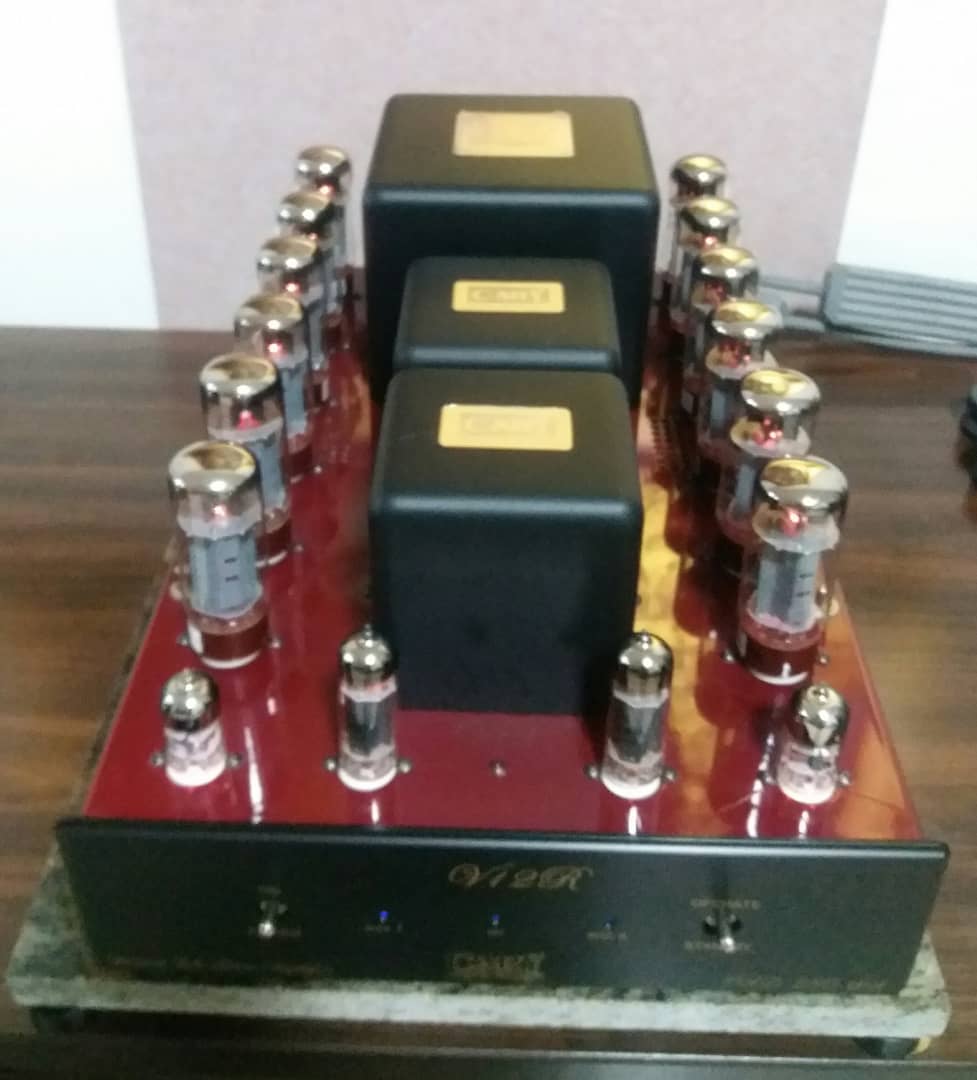Cary Audio CAD 280SA V12 50Wx2 Triode or 100Wx2 UL Power Amplifier in Jaguar Carnival Red Finish
Hi-Fi 4 Sale - Malaysia / Singapore Audio Forum & Marketplace | www.hifi4sale.net :: Audio & Video Equipment Marketplace :: Audio & Video Equipment: FOR SALE (Pre-owned & Used)
Page 1 of 1
 Cary Audio CAD 280SA V12 50Wx2 Triode or 100Wx2 UL Power Amplifier in Jaguar Carnival Red Finish
Cary Audio CAD 280SA V12 50Wx2 Triode or 100Wx2 UL Power Amplifier in Jaguar Carnival Red Finish
Item: Cary Audio CAD 280SA V12 50Wx2 Triode or 100Wx2 UL Power Amplifier in Jaguar Carnival Red Finish
Condition: Bought 2 months ago as New Old Stock. Not run in yet. Original Ruby tubes.
Price: RM11,800 or swap/topup
Contact: 012-3816611
TECH SPECS
Two-channel, push-pull tube power amplifier. Tube complement: two 6922 input tubes, two SV83/EL84 driver tubes, twelve EL34 output tubes. Inputs: RCA or XLR, switch-selectable. Outputs: three five-way binding posts, red for 4 and 8 ohm transformer taps, black for ground. Specified output power: 50Wpc (17dBW) triode, 100Wpc (20dBW) ultralinear. Input sensitivity: 2V for full output. Input impedance: 150k ohms. Noise and hum: 84dB below rated output. Frequency response at full power output: 20Hz-23kHz, ±1dB. Power consumption: 420W Operate, 10W Standby.

According to Cary Audio designer Dennis Had in this amplifier's documentation, "Countless hours were spent designing and voicing the CAD-280SA V12 stereo amplifier...It delivers high performance in a combination of class-A single-ended triode and true balanced push-pull technology."
image: https://www.stereophile.com/images/archivesart/601carypic1.jpg
 Whew, I thought to myself. Push-pull. Thank goodness—it oughta measure pretty well. I read on.
Whew, I thought to myself. Push-pull. Thank goodness—it oughta measure pretty well. I read on.
"The new V12 is created by a stunning combination of the world-famous CAD-805 soundstage, the glorious midrange of the CAD-300-SE, and the supercharged power of the CAD-211-Ms."
Never above a little high-minded self-promotion, eh, Mr. Had?
"The V12 is designed with a fresh and uncompromising push-pull circuit in every criterion. In reality, think of the V12 as four single-ended class-A amplifiers operating in a combined balanced configuration."
In reality, think of John Atkinson having to measure four separate amplifiers instead of one! Heh-heh...In case you were wondering, all four amps on this stereo chassis operate without any form of negative feedback.
"Another design criterion was to utilize only modestly priced vacuum tubes available from multiple tube manufacturing sources. For those of you not aware, I am a triode-crazed audiophile."
I wondered who might not be aware of that by now.
"Do EL34s or KT88s have any merit? They sure do! Simply take a look at their curves when connected in the triode mode. Looks similar to the good old 300B or 2A3. Even the 6L6 looks like a great tube when run in triode configuration."
I coulda Had a V8!
The Cary CAD-280SA V12 is a handsome amp, and smaller than its name might lead you to think. In fact, it's an interesting combination of the neat'n'petite and pure flamboyance. The chassis top is finished in a deep, lustrous "Jaguar Carnival Red." Two output transformers are centered in front of a larger, somewhat imposing power transformer on the top plate, all encased in matte-black covers with rounded-off corners and gold labels on top. The EI-laminated power transformer has a 200% duty cycle; the two output transformers are EI-laminated, and silicone-impregnated to boot.
Down either side of the top chassis sit the 12 output tubes, a red LED indicator behind each one, next to a Triode/Ultralinear toggle switch for each tube pair. Arrayed across the front of the top plate are the small-signal tubes: The outside pair are 6922s configured as inputs, while the inner two are slightly taller SV83/EL84s, used to supply the current to drive the output tubes.
The low-profile front panel is of nicely machined, black-anodized aluminum with a power On/Off toggle on the left, a high-voltage On/Off toggle on the right, between them three small blue LEDs to indicate the presence of high voltage and left- and right-channel bias voltage.
The rear apron sports both RCA and XLR inputs, selectable with a toggle switch, and three five-way binding posts: two red ones (positive) for 4 and 8 ohms, and a single black one (negative) for ground. A standard IEC power-cord socket is centered on the rear panel, above an array of fuses. The two outer fuses are for tube protection (0.5A, fast-blow, 250V); between them are a power AC fuse to protect the power transformer from over-current (3A, slow-blow, 250V), and another (2A, slow-blow) to protect the filament transformer windings from over-current.
Audiophile goodies include 1% metal-film resistors, oil-filled capacitors, and four 560µF power-supply capacitors rated at 400V.
Circuit and tubes
The CAD-280SA V12 is capable of performing in two classes of operation. "The absolute best sounding mode is class-A triode," Dennis Had proclaims in the manual. In triode, the V12 belts out a healthy 50Wpc. For headbanger listening sessions, you might want to select class-AB ultralinear operation for 100W; or 2/3 triode, 1/3 ultralinear for 65W. Had told me it's okay to run the amp "mixed-mode," but despite that, the manual urges you to "Make sure all six switches are set to the same position." Changing modes of operation can be done on the fly by simply flipping the six toggle switches on the chassis top, even as music plays. To keep the waveform symmetrical, if running 2/3 triode and 1/3 ultralinear, you must flip only the center two switches into UL. But "I can tell you that the sound of class-A triode operation is truly the best mode for serious music listening," insists Mr. Had.
The output stage uses twelve EL34 output tubes with a fixed-bias topology that supplies an equal negative-bias voltage "to ensure maximum linearity." This biasing scheme allows the use of many different output tubes—you can run KT88s, 6550s, KT90s, KT66s, or 6L6s! "One might even wish to listen with 6V6s!" the manual enthuses, without explaining why one might wish this. Output power is 50Wpc in triode with EL34s, KT88s, 6550s, or KT90s. KT66s, 6L6s, and 6V6s are lower-dissipation tubes that yield 30-35W in triode. "Speaking of output power," the manual states, "your new V12 has a peak power envelope of 72W into an average loudspeaker load in triode mode." I wondered, wickedly, at what distortion level that might be. I'm sure JA will have an answer.
Each type of output tube presents its own sonic signature, but I reviewed the CAD-280SA V12 with the supplied matched pairs of Ruby EL34s. If you decide to do a little tube rolling, or if a tube goes down and you replace the pair (you'll need six matched pairs of output tubes for the V12), or if you just wear out your fire bottles over time and need to replace them all, you have to go through a bias-adjustment routine for each channel. (The V12 is biased at the factory before shipment and the tubes are marked for each socket; as delivered, the amp is ready to fire up without fuss.)
Each channel sports a bias potentiometer on the rear panel, with a locknut and a ¼" jack for your voltmeter (VOM). In addition, there are the little red LEDs that sit behind each tube on the top chassis. "These LEDs can be referred to as the 'good health' tube indicators," writes the ever-whimsical Had in the manual. "With just a simple glance you'll be able to see that each tube is functioning properly by the red glow of its LED. You can even bias the V12 using just the 12 LEDs if you don't have a VOM."
Here's how it works. If the amp is new, just stuff the tubes into the sockets, matching the numbers on the box with the tube positions indicated in the manual. When installing a new set of 12—or just a matched pair, if you've discovered a bad tube—begin by twisting one or (if required) both bias pots on the rear panel all the way counterclockwise. Then light up the amp by flipping the power On switch and watch for the three small blue LEDs (high voltage, left- and right-channel bias voltage) centered on the front panel to come on. Switch from Standby to Operate and make sure all the output-tube filaments light up.
Read more at https://www.stereophile.com/tubepoweramps/601cary/index.html#ZlxIrZoJrPIhk83j.99



Website:
http://www.caryaudio.com/product-support/cad-280sa-v12/
https://www.stereophile.com/tubepoweramps/601cary/index.html
http://kahlaudio.com/products/cary-audio-cad-280sa-v12r-stereo-tube-amp-stereophile-recommended-4500-msrp/
https://tmraudio.com/old-products/cary-audio-cad-280sa-v12-tube-amplifier-in-factory-box/
http://www.audioreview.com/product/amplification/amplifiers/cary-audio-design/cad-280-sa-v-12.html
VIEW ALL MY OTHER STUFFS BY CLICKING BELOW:
https://my.carousell.com/hifijunction/
https://my.carousell.com/hifijunction/
https://my.carousell.com/hifijunction/
Thank you
Condition: Bought 2 months ago as New Old Stock. Not run in yet. Original Ruby tubes.
Price: RM11,800 or swap/topup
Contact: 012-3816611
TECH SPECS
Two-channel, push-pull tube power amplifier. Tube complement: two 6922 input tubes, two SV83/EL84 driver tubes, twelve EL34 output tubes. Inputs: RCA or XLR, switch-selectable. Outputs: three five-way binding posts, red for 4 and 8 ohm transformer taps, black for ground. Specified output power: 50Wpc (17dBW) triode, 100Wpc (20dBW) ultralinear. Input sensitivity: 2V for full output. Input impedance: 150k ohms. Noise and hum: 84dB below rated output. Frequency response at full power output: 20Hz-23kHz, ±1dB. Power consumption: 420W Operate, 10W Standby.

According to Cary Audio designer Dennis Had in this amplifier's documentation, "Countless hours were spent designing and voicing the CAD-280SA V12 stereo amplifier...It delivers high performance in a combination of class-A single-ended triode and true balanced push-pull technology."
image: https://www.stereophile.com/images/archivesart/601carypic1.jpg
 Whew, I thought to myself. Push-pull. Thank goodness—it oughta measure pretty well. I read on.
Whew, I thought to myself. Push-pull. Thank goodness—it oughta measure pretty well. I read on."The new V12 is created by a stunning combination of the world-famous CAD-805 soundstage, the glorious midrange of the CAD-300-SE, and the supercharged power of the CAD-211-Ms."
Never above a little high-minded self-promotion, eh, Mr. Had?
"The V12 is designed with a fresh and uncompromising push-pull circuit in every criterion. In reality, think of the V12 as four single-ended class-A amplifiers operating in a combined balanced configuration."
In reality, think of John Atkinson having to measure four separate amplifiers instead of one! Heh-heh...In case you were wondering, all four amps on this stereo chassis operate without any form of negative feedback.
"Another design criterion was to utilize only modestly priced vacuum tubes available from multiple tube manufacturing sources. For those of you not aware, I am a triode-crazed audiophile."
I wondered who might not be aware of that by now.
"Do EL34s or KT88s have any merit? They sure do! Simply take a look at their curves when connected in the triode mode. Looks similar to the good old 300B or 2A3. Even the 6L6 looks like a great tube when run in triode configuration."
I coulda Had a V8!
The Cary CAD-280SA V12 is a handsome amp, and smaller than its name might lead you to think. In fact, it's an interesting combination of the neat'n'petite and pure flamboyance. The chassis top is finished in a deep, lustrous "Jaguar Carnival Red." Two output transformers are centered in front of a larger, somewhat imposing power transformer on the top plate, all encased in matte-black covers with rounded-off corners and gold labels on top. The EI-laminated power transformer has a 200% duty cycle; the two output transformers are EI-laminated, and silicone-impregnated to boot.
Down either side of the top chassis sit the 12 output tubes, a red LED indicator behind each one, next to a Triode/Ultralinear toggle switch for each tube pair. Arrayed across the front of the top plate are the small-signal tubes: The outside pair are 6922s configured as inputs, while the inner two are slightly taller SV83/EL84s, used to supply the current to drive the output tubes.
The low-profile front panel is of nicely machined, black-anodized aluminum with a power On/Off toggle on the left, a high-voltage On/Off toggle on the right, between them three small blue LEDs to indicate the presence of high voltage and left- and right-channel bias voltage.
The rear apron sports both RCA and XLR inputs, selectable with a toggle switch, and three five-way binding posts: two red ones (positive) for 4 and 8 ohms, and a single black one (negative) for ground. A standard IEC power-cord socket is centered on the rear panel, above an array of fuses. The two outer fuses are for tube protection (0.5A, fast-blow, 250V); between them are a power AC fuse to protect the power transformer from over-current (3A, slow-blow, 250V), and another (2A, slow-blow) to protect the filament transformer windings from over-current.
Audiophile goodies include 1% metal-film resistors, oil-filled capacitors, and four 560µF power-supply capacitors rated at 400V.
Circuit and tubes
The CAD-280SA V12 is capable of performing in two classes of operation. "The absolute best sounding mode is class-A triode," Dennis Had proclaims in the manual. In triode, the V12 belts out a healthy 50Wpc. For headbanger listening sessions, you might want to select class-AB ultralinear operation for 100W; or 2/3 triode, 1/3 ultralinear for 65W. Had told me it's okay to run the amp "mixed-mode," but despite that, the manual urges you to "Make sure all six switches are set to the same position." Changing modes of operation can be done on the fly by simply flipping the six toggle switches on the chassis top, even as music plays. To keep the waveform symmetrical, if running 2/3 triode and 1/3 ultralinear, you must flip only the center two switches into UL. But "I can tell you that the sound of class-A triode operation is truly the best mode for serious music listening," insists Mr. Had.
The output stage uses twelve EL34 output tubes with a fixed-bias topology that supplies an equal negative-bias voltage "to ensure maximum linearity." This biasing scheme allows the use of many different output tubes—you can run KT88s, 6550s, KT90s, KT66s, or 6L6s! "One might even wish to listen with 6V6s!" the manual enthuses, without explaining why one might wish this. Output power is 50Wpc in triode with EL34s, KT88s, 6550s, or KT90s. KT66s, 6L6s, and 6V6s are lower-dissipation tubes that yield 30-35W in triode. "Speaking of output power," the manual states, "your new V12 has a peak power envelope of 72W into an average loudspeaker load in triode mode." I wondered, wickedly, at what distortion level that might be. I'm sure JA will have an answer.
Each type of output tube presents its own sonic signature, but I reviewed the CAD-280SA V12 with the supplied matched pairs of Ruby EL34s. If you decide to do a little tube rolling, or if a tube goes down and you replace the pair (you'll need six matched pairs of output tubes for the V12), or if you just wear out your fire bottles over time and need to replace them all, you have to go through a bias-adjustment routine for each channel. (The V12 is biased at the factory before shipment and the tubes are marked for each socket; as delivered, the amp is ready to fire up without fuss.)
Each channel sports a bias potentiometer on the rear panel, with a locknut and a ¼" jack for your voltmeter (VOM). In addition, there are the little red LEDs that sit behind each tube on the top chassis. "These LEDs can be referred to as the 'good health' tube indicators," writes the ever-whimsical Had in the manual. "With just a simple glance you'll be able to see that each tube is functioning properly by the red glow of its LED. You can even bias the V12 using just the 12 LEDs if you don't have a VOM."
Here's how it works. If the amp is new, just stuff the tubes into the sockets, matching the numbers on the box with the tube positions indicated in the manual. When installing a new set of 12—or just a matched pair, if you've discovered a bad tube—begin by twisting one or (if required) both bias pots on the rear panel all the way counterclockwise. Then light up the amp by flipping the power On switch and watch for the three small blue LEDs (high voltage, left- and right-channel bias voltage) centered on the front panel to come on. Switch from Standby to Operate and make sure all the output-tube filaments light up.
Read more at https://www.stereophile.com/tubepoweramps/601cary/index.html#ZlxIrZoJrPIhk83j.99



Website:
http://www.caryaudio.com/product-support/cad-280sa-v12/
https://www.stereophile.com/tubepoweramps/601cary/index.html
http://kahlaudio.com/products/cary-audio-cad-280sa-v12r-stereo-tube-amp-stereophile-recommended-4500-msrp/
https://tmraudio.com/old-products/cary-audio-cad-280sa-v12-tube-amplifier-in-factory-box/
http://www.audioreview.com/product/amplification/amplifiers/cary-audio-design/cad-280-sa-v-12.html
VIEW ALL MY OTHER STUFFS BY CLICKING BELOW:
https://my.carousell.com/hifijunction/
https://my.carousell.com/hifijunction/
https://my.carousell.com/hifijunction/
Thank you
 Similar topics
Similar topics» Cary Audio SA-200.2 Stereo Power Amplifier (Used) SOLD
» Cary Audio Model 7.125 Seven Channel Power Amplifier (Used) SOLD
» Cary Audio Design CAD-805 monoblock power amplifier sold out
» Cary Audio CAD-120s power amplifier (Display set) Price Reduced
» Cary audio design CDP-1 cd player , CAP-1 preamplifier & CAA-1 power amplifier (Used)SOLD
» Cary Audio Model 7.125 Seven Channel Power Amplifier (Used) SOLD
» Cary Audio Design CAD-805 monoblock power amplifier sold out
» Cary Audio CAD-120s power amplifier (Display set) Price Reduced
» Cary audio design CDP-1 cd player , CAP-1 preamplifier & CAA-1 power amplifier (Used)SOLD
Hi-Fi 4 Sale - Malaysia / Singapore Audio Forum & Marketplace | www.hifi4sale.net :: Audio & Video Equipment Marketplace :: Audio & Video Equipment: FOR SALE (Pre-owned & Used)
Page 1 of 1
Permissions in this forum:
You cannot reply to topics in this forum









